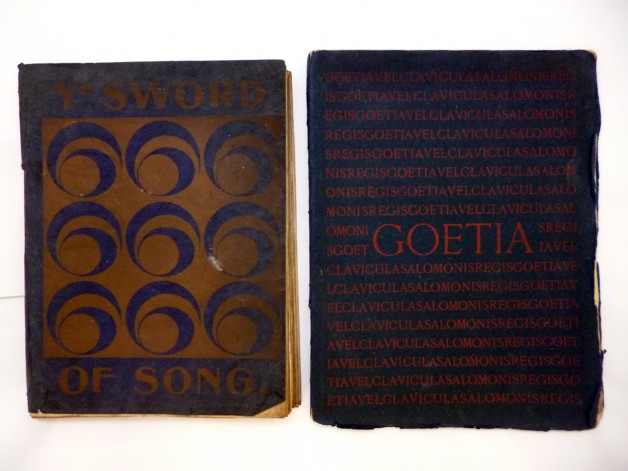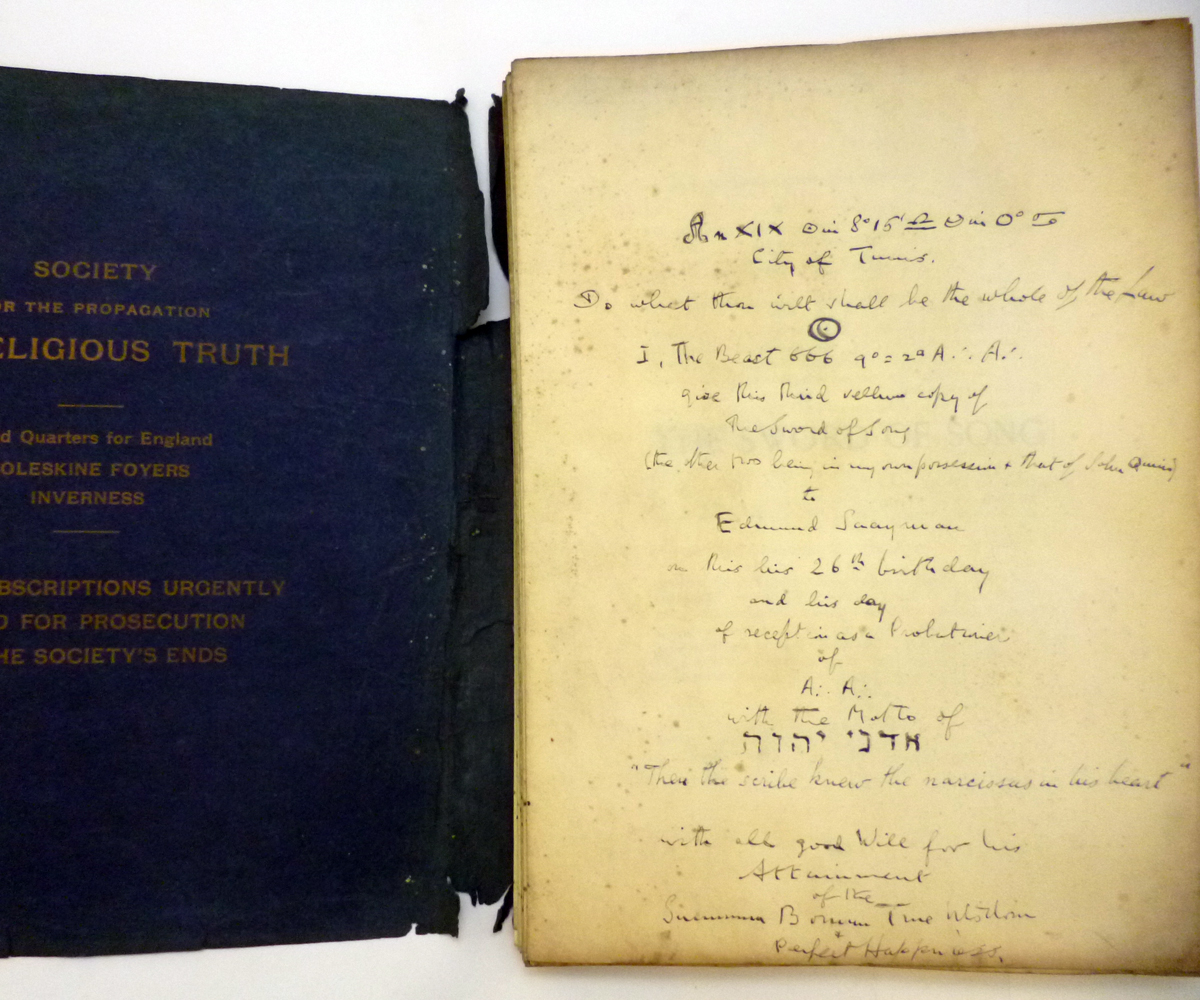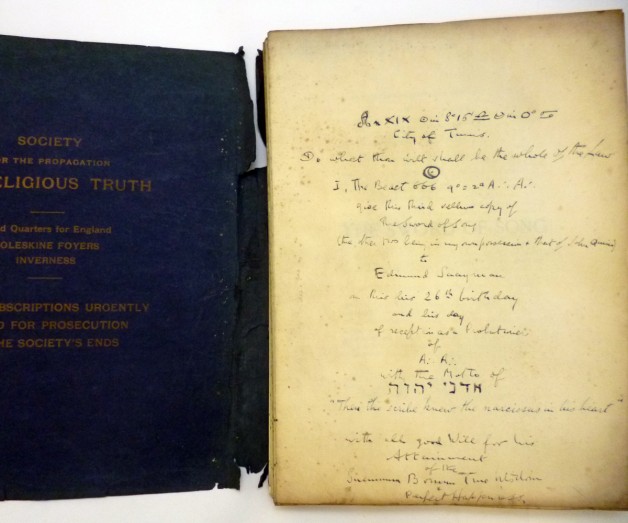This morning Keys Fine Art Auctioneers sold a pair of Crowley first editions from 1904: a copy of the Crowley/Mathers Goetia and a rare vellum edition of The Sword of Song. Judging from the photographs, both books have seen better days; however the Sword of Song is not only a rare variant but contains a long inscription to mathematician Edmund Saayman. LAShTAL.com reports that the pair of books sold for £9,635 including commission.
The Sword of Song is a collection of poems and essays written by Crowley at a time when he was working out questions of philosophy, science (especially Darwin’s bulldog, Thomas Henry Huxley) , rationalism, Christianity, Buddhism, kabbalah, and skepticism. As Crowley explains in his Confessions,
I was criticizing [Browning’s “Christmas Eve” and “Easter Day”] in the light of my experience in Dhyana, and the result was to give me the idea of answering Browning’s apology for Christianity by what was essentially a parody of his title and his style. My poem was to be called “Ascension Day and Pentecost.”
I wrote “Ascension Day” at Madura on November 16th and ‘Pentecost” the day after; but my original idea gradually expanded. I elaborated the two poems from time to time, added “Berashith”–of which more anon–and finally “Science and Buddhism,” an essay on these subjects inspired by a comparative study of what I had learnt from Allan Bennett and the writings of Thomas Henry Huxley. These four elements made up the volume finally published under the title The Sword of Song. (p. 257).
This book gives insight into Crowley’s thinking prior to receiving The Book of the Law, and is significant in representing his first publication with talismanic intent in its design. Its mix of poetry, essay, and humor served as the blueprint for later works such as Konx Om Pax (1907) and The Book of Lies (1913). After Crowley’s Rites of Eleusis caused a stir in the tabloids, The Sword of Song‘s “Ambrosii Magi Hortus Rosarum” would be one of the damning texts around which the Jones v. The Looking Glass libel case would revolve.
Crowley commissioned Parisian printer Philippe Renouard to produce variants of The Sword of Song in order to give the impression of popularity: 10 copies (constituting the “first” edition) were printed on glazed foreign paper and bound in red wrappers; another 90 were bound in blue wrappers with gilt designs on the front and back; an additional three copies were printed on vellum and bound in blue wrappers similar to the other 90 copies. One of the vellum copies (the John Quinn copy) was rebound by Zaehnsdorf in full blue crushed levant morocco.
The vellum Sword of Song is thus one of only three copies. The inscription is most impressive:
An XIX [Sun] in 8° 15′ [Libra, Moon] in 0° [Cancer]
City of Tunis
Do what thou wilt shall be the whole of the Law.
[Symbol of Sun and Moon conjoined]
I, The Beast 666 9°=2▫ A∴ A∴
give this third vellum copy of
The Sword of Song
(the other two being in my own possession & that of John Quinn)
to
Edmund Saayman
on this his 26th birthday
and his day
of reception as a Probationer
of
A∴ A∴
with the motto of
אדני יהוה
“Then the scribe knew the narcissus in his heart”
with all good will for his
Attainment
of the
Summum Bonum, True Wisdom
&
Perfect Happiness.
[The quote “Then the scribe knew the narcissus in his heart” is from Liber Cordis Cincti Serpente vel LXV sub figura אדני, I: 49.]
Mathematician Eddie Saayman was introduced into Crowley’s circle by fellow mathematician and Thelemite Norman Mudd, and was accepted as a Probationer on October 2, 1923. According to Perdurabo: The Life of Aleister Crowley:
Edmund Hugo Saayman (1897–1971) was born at Orange Free State in southern Africa, attending Boys High School in Riversdale and Grey University College in Bloemfontein, where he earned his BS degree. He arrived in the United Kingdom in October 1921 as a Rhodes Scholar attending New College, Oxford. Here, he was supervised by prominent English mathematician and number theorist G. H. Hardy (1877–1947). After his summer holiday with Mudd, he would return to Oxford to marry Janet Stokes in 1924, receive his BA with a third class in maths in 1925 and his MA in 1927. As a physics master at High Pavement School, Nottingham, and a part-time lecturer at Leicester University College, he would publish several influential papers in physics. (p. 399)
This was a tumultuous time in Thelemic history: Raoul Loveday had died in February 1923. That spring, Crowley had to leave Italy when his visa was not renewed, leaving the remaining occupants of the Abbey of Thelema to carry on with the Great Work themselves, eking out an existence and paying the rent as best they could. Displaced to Tunisia, it was here that Crowley would write the Djeridensis Comment on The Book of the Law (or the Comment Called D for short).
Click here for more photos of the auctioned copies of The Sword of Song and The Goetia.



“Ambrosii Magi Hortus Rosarum” is also to be found in the new Wordsworth edition of “The Drug and other Stories”…
Thanks so much for pointing that out, William!
For details, readers can refer to the blog post here: http://zeroequalstwo.net/revised-expanded-second-edition-of-the-drug-and-other-stories/